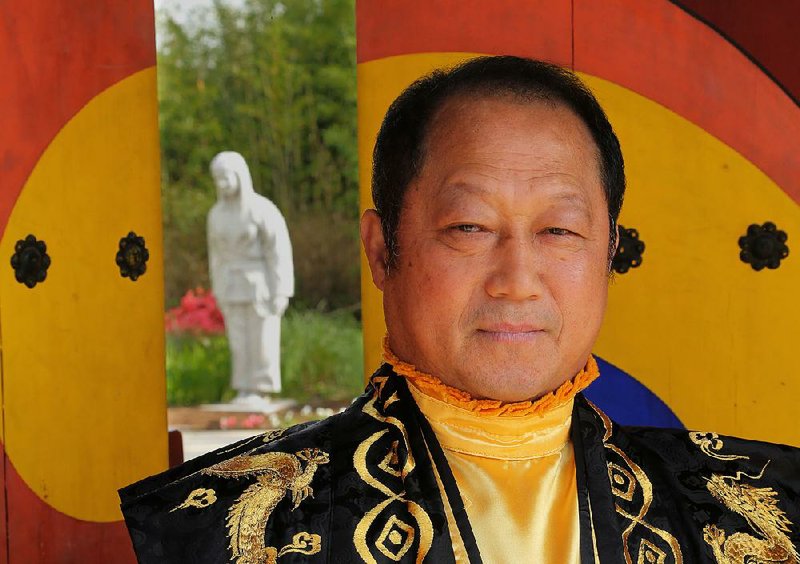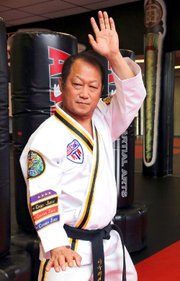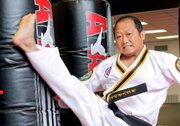In Ho Lee may be a man of small stature, but he can well defend himself -- if need be.
Watching him demonstrate side kicks and round kicks on a punching bag is enough to make the observer feel sorry for that inanimate black object.
Date and place of birth: Feb. 24, 1955, Seoul, South Korea.
One word to sum me up: Changsan. This is the Korean nickname my brother [H.U. Lee] gave me. We all had nicknames. His was “Songahm,” which means “the pine tree and the rock” and describes the type of tae kwon do we practice.
The most important thing I learned from eternal grand master H.U. Lee is to be humble.
The essential ideal behind Tae kwon do is history, values, tradition.
My favorite martial arts legends: My brother and Bruce Lee!
The toughest element of Tae kwon do for me to learn was: Focus
The best benefit Tae kwon do offers to children and young people is the life skills, the confidence, the discipline.
These skills -- combined with healthy helpings of knowledge, wisdom and good will -- have Lee standing tall in the black-and-gold uniform of the grand master of Songahm tae kwon do.
Lee, 60, is head of the American Taekwondo Association. On its website, ataonline.com, it's billed as the world's largest centralized martial arts organization, with more than 300,000 students in 17 countries. Begun 46 years ago in Omaha, Neb., and headquartered in Little Rock since 1977, the association's new philosophy and identity as of 2014 is "Always take action."
As grand master, Lee figuratively -- and at times, literally -- holds the BeeRyongBong, also known as the staff of the grand master. The elaborate ceremonial staff is used exclusively by Lee to anoint new masters of the Songahm fighting technique.
He will be doing just that at this year's World Expo, scheduled for July 8-12 at the Statehouse Convention Center in Little Rock. Held in the city each year, the expo has been ranked as its largest convention, benefiting the city to the tune of what Lee says is now about $8 million. The expo will include competition among students from the association's 1,500 independently owned and operated licensed schools and clubs worldwide; a conference; and special events, including the July 8 induction of new masters in the H.U. Lee Memorial Garden at the convention center.
For Lee, who tempers the dignity of his position with a grin that shows his sly sense of humor, this isn't just about business. It's about tae kwon do and its benefits.
Tae kwon do certainly made a difference in his life.
"I know the training and the life skills were powerful," he says, remembering his early days of training with his older brother, late association founder Haeng Ung "H.U." Lee. "It doesn't surprise me that it has made such an impact on so many people."
Lee follows in the footsteps of H.U. Lee and another of his brothers, Soon Ho Lee. Now referred to as eternal grand master, H.U. Lee developed the Songahm style of tae kwon do and founded the association, becoming its grand master in 1990. A year after his death in 2000, Soon Ho Lee assumed the title and held it until his retirement in 2011.
Actually, In Ho Lee is "kind of referred to as the head grand master," says chief master Richard Reed of Scottsdale, Ariz. Reed is a charter member of the association who helped bring H.U. Lee to the United States and is set to be elevated to grand master rank at the expo.
The head grand master is "the guy who gets to do all the work, especially the travel" to various association-sanctioned tournaments, ceremonies and other events.
Lee has done an outstanding job heading the association and dealing with the sacrifices, he says.
"He has a great time with it and especially the kids in the ATA all love him. ... I think he's well thought of throughout the ATA land."
Songahm means "pine tree and rock." Students of association-licensed schools advance in the art via belts, starting with the white belt and going to black. Black belt holders may advance still and earn master rankings. Association programs include Black Belt Academy; Karate for Kids; ATA Tigers for preschool age children ages 2 through 6; and Protech Training, advanced martial arts training, including weapons training and specialized self-defense tactics.
"As much as the martial art, it stresses the attitude about one's self and how one person relates to other people in the world in a very respectful way," says Little Rock Mayor Mark Stodola, who lauds the association for such initiatives as its Kidz'n Power Bullying Prevention Program for schoolchildren. "If you've ever watched them do some of their exhibitions, it makes you very proud of what they're teaching."
It's precisely because of the young people, Lee says, that they keep the association going.
"Our kids, as they are performing, they're growing with their attitude," he says.
Lee is now leading a campaign to raise the profile of martial arts based on his participation in the President's Challenge, part of the President's Council on Fitness, Sports and Nutrition. Program participants can earn points for every activity they log in the program's activity tracker, earning bronze, silver, gold and platinum awards.
Of the top 10 most popular President's Challenge activities, martial arts stands at No. 8. Lee believes that if all students of martial arts in the country were to participate in the challenge, martial arts would stand at No. 1.
BUILDING FROM WITHIN
Each new grand master has a mandate to build upon what the previous titleholder did. Each brings his own personal philosophy showcased in a motto. H.U. Lee's was "Today impossible, tomorrow possible." Soon He Lee's was "As long as we know there is always more to learn, anything is possible."
"And what I'm saying as the third generation is ... 'Change yourself first,'" Lee says.
"An example of this ... I try to tell my wife to do something, she's never going to do it," he says jokingly. "But if I change my attitude [toward] her ... then she will change. ... You have to change first if you want to influence somebody to change."
For anyone who's still watching those old movies from the 1970s and thinking martial arts is about proving one's toughness, Lee would like to set them straight. It's not about "a bloody fight" or "revenge." Tae kwon do is building the self physically and mentally, he says. "Building [an] independent human being is the tae kwon do goal. Our goal is to be humble human beings."
According to Lee's official biography, being bullied because he was small was one of the main reasons for his interest in martial arts. But he didn't learn tae kwon do to beat anyone. "If somebody ... wants to show off, that means that they do not [have] confidence in themself," he says. "Once you're secure, you're really calm in yourself, you don't have to ... show off." Tae kwon do elements -- forms, sparring, board breaking -- "already shows your power, evidence of that power. You don't have to be a bully." He laughs. "I'm a nice guy, you know."
Tae kwon do brings not only confidence but discipline to those who persevere in it, Lee says. "But ... if you want to self-defend, yes, you can. That's the whole purpose of using it ... a dangerous situation, not to show off. That's not what we're training for.
"As you go through the belts, self-victory is the key. That's been the slogan for ATA for many years."
According to his biography, Lee -- a member of the 44th generation of Lees and the fifth son in his family -- was born in Seoul, South Korea, two years after the end of the Korean War. He learned tae kwon do with his brothers and cousins. Lee grew to love the art so much he began teaching it as a schoolboy after achieving the rank of blue belt.
Lee went on to serve in the military for a year, after which he joined H.U. Lee in Nebraska in 1976 and began working with him to bring his vision for the association to fruition. Lee remembers the rigorous training under his brother that yielded a "lot of sweat and sore muscles," as he put it.
"Still I'm training," he says.
He, H.U. Lee and several other brothers went on to travel the country, doing demonstrations as the Flying Lee Brothers and educating people about tae kwon do. For many, it was their first time seeing tae kwon do, Lee says. When the tour ended in 1977, In Ho Lee moved to Little Rock with his brothers, and with them, the association's headquarters.
Lee served in various capacities within the association, working with its accounting, testing and tournament departments and helping implement World Martial Arts, the association's supply company. He also served on the Masters Council and the Founders Council. He became grand master in 2011 after an intense year that included a global tour and the completion of a nine-step process that included:
• Meeting a fitness level that put him in the top 10 percent of his age group.
Passing this step was especially significant for Lee, who'd overcome a Type 2 diabetes diagnosis at a time when he'd devoted himself to paperwork and slacked off on his physical well-being. Healthful eating, and a return to tae kwon do training, suspended his diabetes treatments.
• Spending three days at the same Korean temple at which the two previous grand masters stayed during their preparatory periods.
During these three days, Lee had to maintain total silence, with a member of the Masters Council there to document the first words he spoke after this period ended. So what was Lee's first word? "Silence," he says. "It was on my mind beyond everything else, because it was what I wrestled with those three days. All my senses came alive during the meditations and the fasting. But the silence was difficult. Three days, it's impossible not to talk. I'm still working on silence."
• Daily physical and mental training, including spending a day as a student with each member of the Masters Council "to fully appreciate the role of both student and instructor." No problem for this man who so enjoys teaching. "Instructor means ... you're learning other things when you teach."
• Learning and demonstrating the grand master ninth degree form at the 2011 association world expo, at which he was inaugurated.
DEDICATED TO THE MISSION
Lee says that the most profound thing he learned during his preparatory period is that "it wasn't about me. It was about carrying on the mission of Songahm tae kwon do."
Chief Master Richard Anderson, known for turning inner-city Little Rock youth into tae kwon do champions, believes Lee does that quite well. "He's an ever-changing individual," Anderson says. "He's always seeking to have knowledge and better himself, but he's a very pleasant grand master. He's firm [but] understanding of everyone's situation."
Lee elevated a recently deceased association master, J.D. Olford of Lufkin, Texas, to the posthumous rank of senior master, Anderson points out. "He's always concerned about all the other instructors, how their business is going and how their students are faring."
By the way, tae kwon do isn't Lee's only specialty. When not performing official duties or spending time with wife Yeon Nam Lee and their two adult children, he's golfing. "He's also a very good golfer," Reed says. "He can get out there and hit it like he's 6 foot 2."
In addition to his own goal to strengthen relationships among the leaders and the younger generation within the Songahm community, Lee has dedicated himself to bringing to fruition the numerous visions H.U. Lee held for the association. One of those visions was to build a tae kwon do "mecca." Another was a tae kwon do college.
In the meantime, the association is receiving state money for the construction of a new corporate headquarters. The association was awarded a $950,000 grant by Gov. Asa Hutchinson, via the Arkansas Economic Development Commission's Quick Action Closing Fund for the facility, to be built on Riverfront Drive in Little Rock's Riverdale area. Approved by the Little Rock Board of Directors on April 21 was a resolution to provide $350,000 for infrastructure for the headquarters, a grant predicated on the fulfillment of the state grant.
"It's a great economic development opportunity for the city," Stodola says.
H.U. Lee moved to Little Rock from Omaha because the scenery and weather reminded him of Korea, Stodola says. "We're very pleased that they've not been lured away."
High Profile on 06/14/2015



